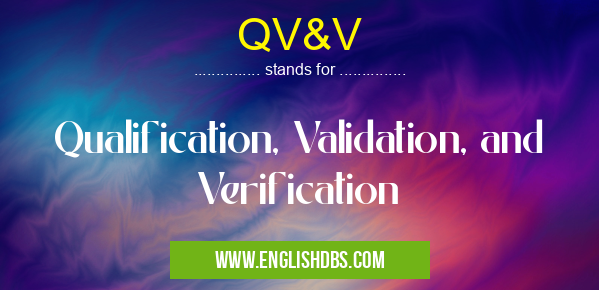What does QV&V mean in SOFTWARE
Qualification, Validation, and Verification (QV&V) are processes used to ensure that a product is correctly designed, manufactured, and tested to meet the requirements and needs of its intended use. QV&V is applicable to all products, services and systems that have technical, safety and/or performance requirements. This includes medical devices, pharmaceuticals and chemicals, automotive components, aircraft designs and parts manufacture. QV&V involves ensuring that the product meets the stated specifications by testing it on all levels such as design verification testing (DVT), manufacturing process validation (MPV), and final production release tests (FPRT).

QV&V meaning in Software in Computing
QV&V mostly used in an acronym Software in Category Computing that means Qualification, Validation, and Verification
Shorthand: QV&V,
Full Form: Qualification, Validation, and Verification
For more information of "Qualification, Validation, and Verification", see the section below.
Qualification
Qualification is the process of validating a design or prototype against established standards or criteria. The purpose of qualification is to ensure that a product can perform its intended functions under normal operating conditions without any risk to user safety or performance degradation. Qualification typically involves running simulations or tests that apply various environmental factors such as temperature and humidity ranges, as well as vibration analysis or stress loading on components. These tests provide evidence that the product will function reliably in different environmental conditions.
Validation
Validation is used to verify that the system has been designed correctly for its intended purpose based on the evaluation of user requirements. It ensures that the specified requirements are being met during manufacturing process activities such as production ready processes or inspection procedures. Validation also includes conducting usability testing in order to confirm if users can effectively interact with the device as well as determine its overall usability.
Verification
Verification is used to assess how well a system meets its expected outcomes when compared with actual results obtained during development cycles. Verification confirms that each module within a system meets its specified design requirements prior to production release. This includes verifying software algorithms for accuracy through automated unit tests and regression tests; hardware components are tested for proper operation; electrical signals are analyzed for their integrity; system performance parameters are monitored throughout development cycles; dimensional integrity is verified before assembly into subassemblies; mechanical components are inspected for tolerances after assembly; etc..
Essential Questions and Answers on Qualification, Validation, and Verification in "COMPUTING»SOFTWARE"
What is Qualification, Validation, and Verification?
Qualification, Validation, and Verification (QV&V) is a process used in Quality Systems to ensure the quality of any product across all stages of the product life cycle. The purpose of QV&V is to confirm that all specifications, requirements and processes are met before releasing a product for use.
Why do we need QV&V?
QV&V serves as an assurance that products consistently meet specified requirements which guarantee customer satisfaction as well as system reliability. It also helps ensure regulatory compliance and minimizes risk.
Which entities require QV&V?
Any entity that produces, provides or sells products should utilize QV& V to verify the accuracy and consistency of the product's performance and safety in the market.
Who is responsible for executing QV& V?
Typically, Quality Assurance departments are responsible for ensuring that all stages of the product life cycle have undergone proper QV & V protocols. The individuals assigned to this task may vary depending on different organizations' needs and regulations.
How often should QV & V be performed?
The frequency of performing QV & V tasks depends on numerous factors including defect rates, industry requirements/regulations, customer complaints/feedback etc. Generally speaking, it's recommended to repeat testing every few months or years depending on the product life cycle stage.
What kind of tests are conducted during QV & V?
Depending on the complexity and nature of the product under consideration various kinds of tests such as functional tests, performance tests, security tests etc may need to be carried out during different stages of the life cycle.
Final Words:
The importance of QV&V cannot be overstated due to its effects on product quality assurance in terms of reliability and safety. Its three processes - qualification, validation and verification - help guarantee quality assurance from design through final delivery. Each step brings added value when applied properly which in turn leads to cost savings due to reduction in rework needed for defective products both during manufacture and operation stages.
